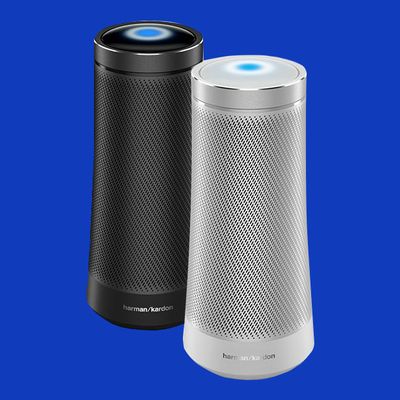
The $199 Harman Kardon Invoke speaker, powered by Microsoft’s Cortana, is a great smart speaker if you’re already deeply embedded within the Microsoft ecosystem. Like, if you have a Windows 10 computer at home and work, use Office 365 and Outlook for all of your calendars and scheduling, and have a Wunderlist addiction. It also sounds fantastic and only costs a bit more than the competition. If you aren’t deeply tied to Microsoft? You may have a great-sounding smart speaker that can’t do much else — and there’s a better-sounding smart speaker for the same price out there as well.
The Sound
This is the highlight of the Invoke. Harman Kardon has a long reputation for putting out great audio, and its recent acquisition by Samsung doesn’t seem to have changed that. The $199 Invoke comes with three woofers, three tweeters, and two passive radiators, which results in noticeably better sound than your standard smart speaker, including the Echo, the Echo Show, and the Google Home, and the Invoke sounded much, much better than all three of them — especially when it came to any song with bass.
I played the Weeknd’s “The Hills,” and the bass drone that kicks during the chorus came through with clarity and power. The rapid bass kicks in FKA Twigs’ “Two Weeks” hit properly, and the low chanting was suitably foreboding, but the Invoke also had the frequency response to let the high-pitched electronic flutters clearly stand out. I listened to Phoenix’s “Lisztomania,” while quickly switching from the Google Home, to Echo Show, then to the Invoke, and it was like popping your ears after a long flight — everything was suddenly much clearer: the ring of guitars, the richness of vocals, and the boom of the kick drum.
I’m not saying the Invoke will suddenly turn your kitchen counter into an audiophile’s dream, but for $199, compared to $99 for the regular Amazon Echo or the $200 for the Echo Show, you’re getting a much better sound. And the Google Home, at $129, will still sound better than the average Bluetooth speaker you may have kicking around your kitchen — but the Invoke is just $70 more and sounds much, much better. (The Google Home Max may fix this, but it’ll retail at $400, and I haven’t had a chance to listen to it.)
That said, I found that the $199 Sonos One — which currently runs Alexa, but will soon open up to Google Assistant — sounded even better than the Invoke. It’s subtle, and not nearly as noticeable as the difference between a base Echo or Google Home versus an Invoke, but it’s there. Which one you pick comes down to whether you want to use Alexa (and, eventually, Google Assistant) or Cortana.
Cortana
If you haven’t used the Windows 10 OS in a bit, you may not have had much of a chance to interact with Cortana. You wake the Invoke by saying, “Hey, Cortana,” a slightly awkward and overlong phrase (though, perhaps, not quite annoying of the two hard-G sounds and schwa of “Okay, Google).
If we place smart speakers on a spectrum from Amazon’s Alexa (excels at performing tasks, but falls short when asked simple questions) to Google Home (still playing catch-up on capabilities, but can answer random questions much more easily), Cortana falls somewhere in the middle. It hooks into Bing to answer questions, and was capable of throwing back pretty good responses to a variety of questions, from “How tall is a giraffe” (on average, the male giraffe grows up to 18 feet in height) to “What’s the difference between mitosis and meiosis?” (I’ve already forgotten whatever it told me.) That said, it drew a complete blank when I asked “Who’s gonna be in the World Series?” — offering up, “I found two results: the Chicago Cubs and Cleveland Indians,” (i.e., the two teams in the World Series last year), and just a blanket, “Sorry, I’m not able to help with that yet.” Both Alexa and Google Home answered the question easily, and didn’t provide potentially traumatic answers for Cleveland fans.
On the flip side, the Invoke already works with Philips Hue, Nest, Wink, SmartThings, and Insteon, meaning it can control a good portion of the smart-home stuff available. Potentially more appealing, it allows you to make voice calls using your Skype account. The good part is that the Invoke’s speakers make people on the other end of the line sound great. The bad news is that in my limited testing, people on the other end of the line when I placed a call using Invoke said my voice sounded tinny and far away. I tested it for myself and they’re right — it sounds about the same as if you’d left your phone on the countertop in speakerphone mode.
There’s a lot more that Cortana can do. It can schedule meetings for you. It can set up to-do lists and reminders. It can check for new emails and even respond to them. But for all these to work, I need to be in Microsoft’s ecosystem, using their products, like Wunderlist, Outlook, and Windows 10. If you’re already in, the transition is pretty seamless — I was able to set up a reminder on Invoke and see it on my Windows 10 home desktop easily. (That said, it can only do this for one account — if my wife, a heavier Windows user than me, also wanted to use Cortana, she’s out of luck.) The Microsoft spokespeople I talked to said they wanted to bring in other services, but were noncommittal about when that would happen, and considering my work computer is a MacBook Pro, and my office and my personal life are largely handled through Gmail and Google Calendar, it’s hard to see the Invoke being much more than a nice-sounding timer and wireless speaker for me. Depending on your home and work setup, your mileage may vary greatly.
The Look
The Invoke takes its clearest cues from the original Echo — its tall, black tower. It slightly flares out at the bottom, which to my eye creates something slightly more organic and less stark than the Echo, but lacks the pure affability you’re seeing from Google, Sonos, and other players in the market. It doesn’t quite blend into the background in the same way these other products do, but this will largely be a matter of taste. It has a volume control that you can see from the top of the device, and adjust via dial, but you can’t really see the volume ring from a side-on view — not a great design choice when building a large tower that will likely be above eye level for anyone seated in a room.
The Bottom Line
If you live and die by your Outlook calendar and have Windows across almost every aspect of your life (there’s a decently designed Cortana app that’ll take care of you on iOS or Android), the Harman Kardon Invoke is a no-brainer. It sounds great, it’s priced right, and generally performed exactly as I needed it to. If that doesn’t describe you, and you want a smart speaker that sounds really good, right now, get the Sonos One — it’s the same price, and despite some small headaches in getting it set up, it’ll serve you well.
If you don’t have a smart speaker and aren’t quite sure where to jump in, either get an Echo Dot or a Google Home Mini for $50 and see if you like it (both can pair with your preexisting home audio system, if you have one). Or wait and see how all this shakes out. The smart-speaker wars are about to begin in earnest — and it’ll probably be at least a year before it’s clear which company, if any, comes out on top.





























